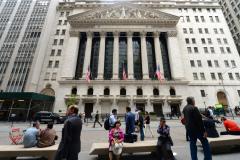Morningstar said Tuesday that May was another strong month of mutual fund inflows: Investors added $38.6 billion into long-term funds, excluding figures for money-market and fund of funds, as well as ETFs.
Taxable-bond funds stayed ahead of the pack with $21 billion in flows.
Investors, who embraced core, intermediate-term bond funds in 2012, are increasingly turning to less interest-rate-sensitive bond sectors and are shunning government bond sectors, according to Michael Rawson, CFA.
In May, interest rates spiked, with the 10-year Treasury rate increasing by nearly half a percent to 2.16%. At the same time, the Barclays Aggregate Bond Index fell 1.78%.
Investors took profits in U.S. equity funds in May “but continued their love affair with emerging-markets stocks,” says Rawson.
Municipal-bond funds experienced net outflows for the third month in a row. Meanwhile, money-market funds (also tracked by Morningstar) grew by $27 billion—their first monthly inflow of 2013.
Darkening Skies
In May, the improving economy and jobs report led to the conclusion that the Fed may ease up on quantitative-easing measures. Flows into the intermediate-term bond category weakened but were positive for the month—and did not turn negative until early June.
In May, it was nontraditional-bond and bank-loan funds that took in the largest share of flows, according to Morningstar.
The PIMCO Total Return Bond had strong outflows. But PIMCO Unconstrained, the largest fund in the nontraditional category, gained more than $1 billion in flows, as did JP Morgan Strategic Income Opportunities.
The bank-loan category also attracted strong inflows, led by Oppenheimer Senior Floating Rate with a $700 million haul. (The fund rose 0.24% in May and 3.54% during the first five months of 2013.
Equity Tremors
The rise in rates did not sit well with equity investors in May.
“While the S&P 500 was up 2.34% for the month, yield-oriented sectors such as REITs and utilities each lost more than 6%, according to Morningstar sector indexes,” Rawson said.
U.S. equity fund investors took out a net $700 million in May, including withdrawals of $1.9 billion from large-growth funds.
On the other hand, international-equity funds gained $8.5 billion, with diversified emerging-markets funds leading the way.
A new fund, ING Emerging Markets Index, “burst onto the scene” with $470 million of inflows in May, says Morningstar. Meanwhile the Vanguard Emerging Markets Stock Index brought in $363 million.
International funds that each brought in more than $1 billion included the Silver-rated GMO International Intrinsic Value and Gold-rated Oakmark International.
(Oakmark International has gained 45% in the past 12 months compared with 28% for the MSCI EAFE Index.)
Fund Family Winners
Vanguard led the pack again, with more than $11 billion in flows.
In May, the fund giant officially launched two international bond funds: the Vanguard Total International Bond Index Fund and Vanguard Emerging Markets Government Bond Index Fund, which didn’t officially start trading until June 4. PIMCO stayed in second place, though its $2.5 billion of flows was its weakest showing for the year to date, Morningstar reports.
Franklin Templeton was close behind PIMCO, adding more than $2 billion; its Templeton Global Bond Fund led the way. Fidelity came in fourth, thanks to strong flows into the Fidelity Series Investment Grade Bond and Strategic Advisers Core Income.
“For the second month in a row, flows to MFS were lifted by a strong interest in Bronze-rated MFS Massachusetts Investors Trust,” said Rawson.
Hartford, Janus and Columbia, however, each had strong outflows.
The Silver-rated Hartford Capital Appreciation saw redemptions of $1.4 billion, while Neutral-rated Janus Fund saw outflows of $481 million.
***
For direct insights on the role of ETFs in client portfolios from multiple experts—including Rick Ferri, Ron Delegge, Skip Schweiss and more—we invite you to register for AdvisorOne’s premiere advisorcentric Virtual ETF Summit, which starts July 23 (and get multiple hours of CFP Board CE).
 Brian Bolan is a Stock Strategist for Zacks.com. He is the Editor in charge of the Zacks Home Run Investor service, a Buy and Hold service where he recommends the stocks in the portfolio.Brian is also the editor of Breakout Growth Trader a trading service that ! focuses o! n small cap stocks and also carries a risk limiting strategy. Subscribers get daily emails along with buy, and sell alerts.Follow Brian Bolan on twitter at @BBolan1Like Brian Bolan on Facebook
Brian Bolan is a Stock Strategist for Zacks.com. He is the Editor in charge of the Zacks Home Run Investor service, a Buy and Hold service where he recommends the stocks in the portfolio.Brian is also the editor of Breakout Growth Trader a trading service that ! focuses o! n small cap stocks and also carries a risk limiting strategy. Subscribers get daily emails along with buy, and sell alerts.Follow Brian Bolan on twitter at @BBolan1Like Brian Bolan on Facebook


 World's hottest diamond markets HONG KONG (CNNMoney) A diamond is forever ... especially in China.
World's hottest diamond markets HONG KONG (CNNMoney) A diamond is forever ... especially in China.  Related AKS Mid-Day Market Update: FMC Slips On Weak Outlook; Integrys Energy Shares Surge AK Steel Unveils Q2 Outlook - Analyst Blog
Related AKS Mid-Day Market Update: FMC Slips On Weak Outlook; Integrys Energy Shares Surge AK Steel Unveils Q2 Outlook - Analyst Blog